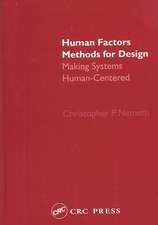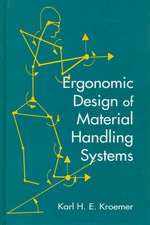Handbook of Control Room Design and Ergonomics: A Perspective for the Future, Second Edition
Editat de Toni Ivergard, Brian Hunten Limba Engleză Hardback – oct 2008
New in the Second Edition:
- Extensive coverage of the use of the control room and its related computer system outside the work of monitoring and supervising the processes
- Discussion and explanation of how the control room can also be used for the purposes of education and simulation training
- Discussion of the use of the control system for optimizing and developing the existing systems and processes
- A section on new ideas and philosophies about organizational design and job design as these are applied to control room related work
- Proposed organizational designs of the future
- Theoretical background about learning, learning in the workplace, and lifelong learning
Creativity and learning are rapidly becoming integral parts of the design of work environments and work processes and utilize the ICT potential of modern control systems. Using original case studies, the authors describe and illustrate some creative and exciting organizational designs of the future, including new perspectives learning, learning in the workplace, and lifelong learning. Taking a holistic view, they make a strong argument for integrating in the workplace of the new control cent
| Toate formatele și edițiile | Preț | Express |
|---|---|---|
| Paperback (1) | 375.74 lei 6-8 săpt. | |
| CRC Press – 23 oct 2019 | 375.74 lei 6-8 săpt. | |
| Hardback (1) | 1117.88 lei 6-8 săpt. | |
| CRC Press – oct 2008 | 1117.88 lei 6-8 săpt. |
Preț: 1117.88 lei
Preț vechi: 1363.27 lei
-18% Nou
Puncte Express: 1677
Preț estimativ în valută:
213.90€ • 223.93$ • 176.99£
213.90€ • 223.93$ • 176.99£
Carte tipărită la comandă
Livrare economică 05-19 aprilie
Preluare comenzi: 021 569.72.76
Specificații
ISBN-13: 9781420064292
ISBN-10: 1420064290
Pagini: 398
Ilustrații: 170 black & white illustrations, 13 colour illustrations, 30 black & white tables
Dimensiuni: 156 x 234 x 25 mm
Greutate: 0.7 kg
Ediția:Revizuită
Editura: CRC Press
Colecția CRC Press
ISBN-10: 1420064290
Pagini: 398
Ilustrații: 170 black & white illustrations, 13 colour illustrations, 30 black & white tables
Dimensiuni: 156 x 234 x 25 mm
Greutate: 0.7 kg
Ediția:Revizuită
Editura: CRC Press
Colecția CRC Press
Public țintă
Academic and Professional Practice & DevelopmentCuprins
Introduction: Work in Control Rooms and Models of Control Room Work. Work in Control Rooms. Models in Process Control. Design of Information and Control Devices. Design of Conventional Information Devices. Design of Large and Complex Display Systems. Design of Controls. Design of Control Rooms and Their Environment. Control Room Layout and Design. Environmental Factors in the Control Room. Case Studies and Applications. Industrial Applications and Case Studies. Maritime Application of Control Systems. The Human Dimension in the Control Room. The Operator’s Abilities and Limitations. Learning and Creativity at Work. Modelling and Simulation in the Pulp and Paper Industry: Current State and Future Perspectives. System Design: An Overview. Conclusions. Conclusions and Recommendations in Summary. Index.
Descriere
Published two decades ago, the first edition of this bestselling handbook became the go-to reference for this field. With more than 20 new chapters and sub-chapters, this second edition delineates modern approaches that emphasize the role of people in learning for self-development and in shaping their work environments. Taking a holistic view, the authors make a strong argument for integrating the work of the new control centers in the context of society as a whole, including global concerns such as environmental protection, energy conservation, and sustainability.



























